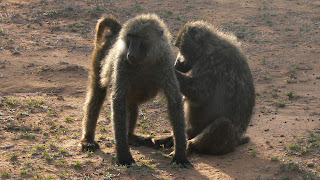 |
| Photo: Alejandra de Argos |
It’s one thing to hear stories of what it’s like living with baboons, and it’s quite another to actually visit a baboon community and experience a part of their life. Baboons are Old World primates not too dissimilar from humans - seeing them in the flesh one is immediately reminded of the importance of Darwin’s work.
Getting to know baboons, and indeed living among them, is a great idea for those curious about human evolution, and those looking to further their understanding of human community.
Baboons share 91% of our DNA and are the largest Old World primates after humans. Biologically, the term baboon is broken down into five distinct species, and they can be found exclusively in Africa and Arabia.
I spent a few days cohabiting with baboons in a rocky savannah in the central part of Laikipia, one of Kenya’s 47 counties. I wasn’t alone - also with me on this adventure was a researcher from a British conservation agency, who strongly advised me never to make direct eye contact with the males due to their short temper and their tendency to pick a fight without warning nor reason. I’d better appear submissive, I was told. Male baboons usually attack each other over group leadership: these attacks are often directed towards other families within the same pack of baboons and tend to lead to the death of the entire family. The males can also exhibit violence towards their own offspring, and towards female members of the species, if they reject their advances. I was given yet more examples of the undesirable behaviour seen in baboons (and, for that matter, humans), but I was also told about the honourable side of these creatures, about the selfless care and generosity they exhibit towards members of their family or pack.
Luckily, my personal overall experience of the behaviour of baboons was a very positive one: the community that I observed on my trip turned out to be particularly sociable. They would spend hours pruning each other of insects and generally looking after each other, the females carrying their babies on their backs, and the males on the look-out for predators from high up on a rock. Despite this community interest, however, the baboons do not enjoy a healthy reputation with the human inhabitants of the area, as they are prone to destroying their crops.
Baboons are certainly considered dangerous when they join forces to attack larger animals. They feed on seeds, grass, fruit and roots, as well as animals of varying sizes, such as birds, rodents or antelopes. They love talking: they are capable of uttering very strange sounds indeed, which they use to communicate and socialize with one another, reassuring them of the presence and trust of their fellow pack members. Baboon communities can reach hundreds of members, structured into rigid hierarchies.
It was a joy to experience a snapshot of the lives of these creatures, so similar to us in many ways. It was there, among the vastness of the African wilderness, among its unique colours and light and landscapes, that it dawned on me how much closer to that world our roots really are than to our modern one.
To end, I’d like to quote the Spanish Neo-darwinist Francisco J. Alaya, one of the world’s most renowned biologists, interviewed by Malén Aznárez:
“Science and religion are two windows onto the world - the view from each is different, but the world that is viewed through each is the same. I believe that they are not mutually exclusive views. The responsibility of science is to explain natural processes through natural laws. Religion, on the other hand, is about the meaning and purpose of life, of our relationships with one another. Science should have no say in such matters; conversely, religion has nothing to contribute to science, as it does not deal with natural laws. The interference between the two disciplines arises when they leave their own area of knowledge in order to influence the other. This is precisely the problem with Christian fundamentalists in the United States, or Islamists in other countries: by treating the Bible as a science textbook, as an academic paper on astronomy or biology, religion starts to contradict science, leading to its own destruction.”

 Cambiar a versión en Español
Cambiar a versión en Español









No comments:
Post a Comment
Muchas gracias por compartir tus comentarios